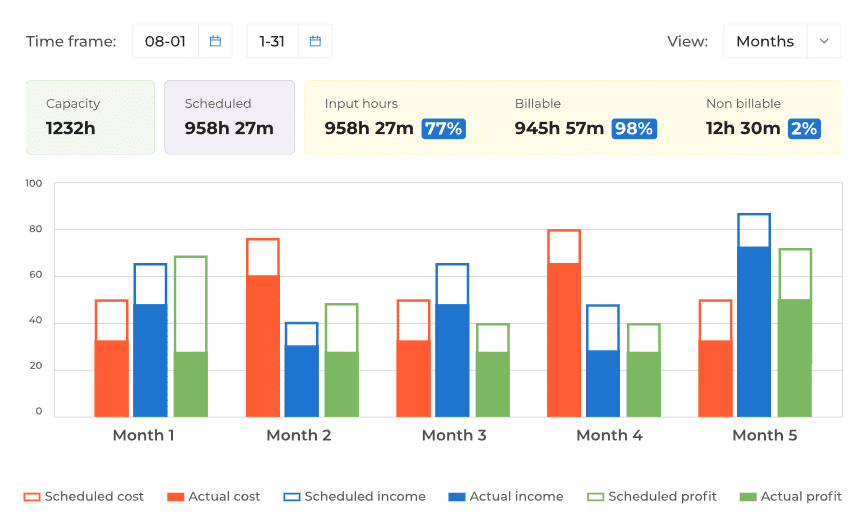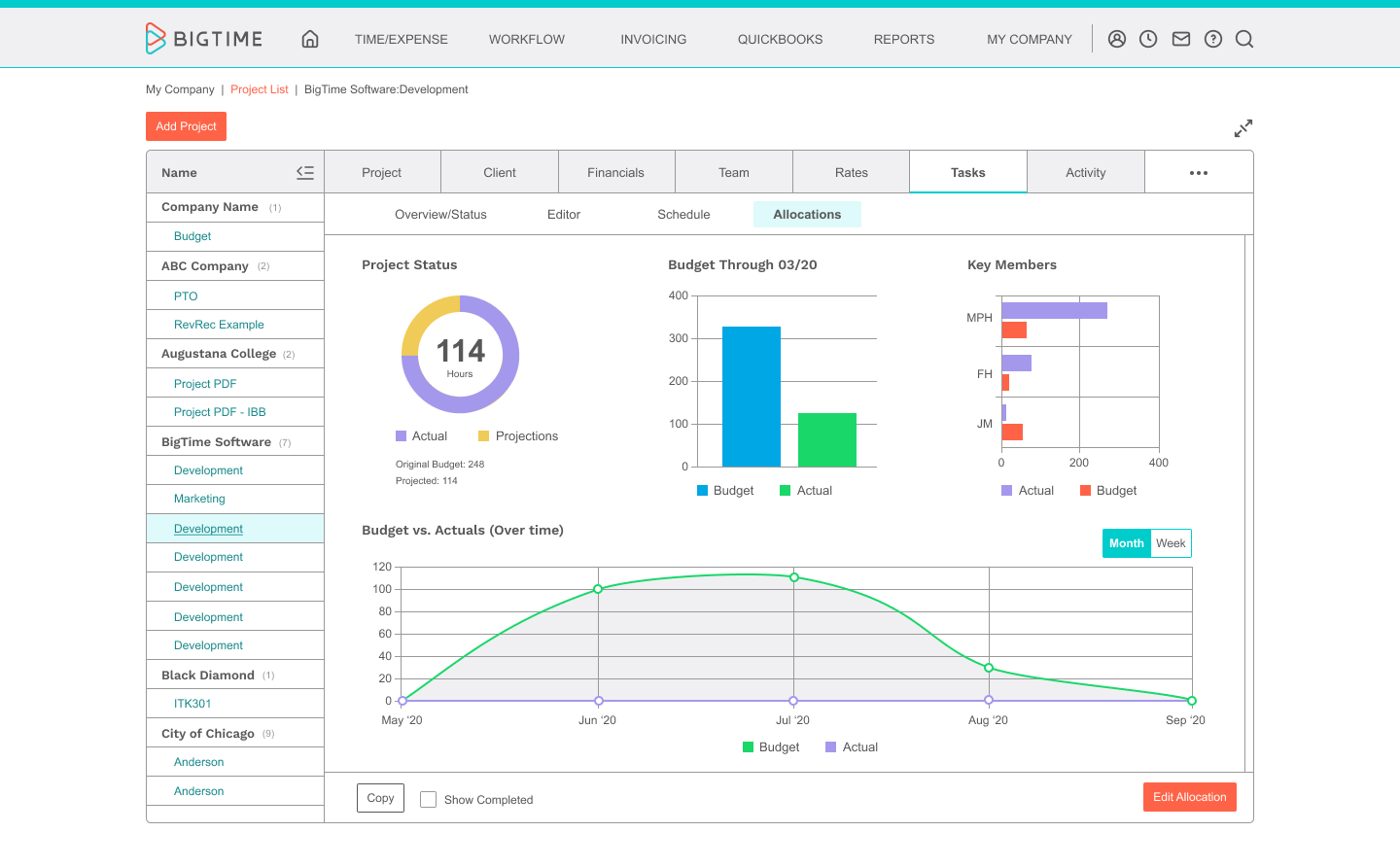Best Utilization Management Software
The features of BigTime's best utilization management sofiware align with the best practices to fully optimize your organization’s mode of operation.
Why Choose BigTime’s Utilization Management Software?
Professional services firms face constant challenges in resource management. Underutilization leads to wasted potential, while overutilization results in burnout and inefficiencies. These challenges directly impact project profitability and employee satisfaction.
The best utilization management software is designed specifically for professional services firms. BigTime offers real-time insights into resource allocation, utilization, and project performance. With robust analytics, seamless integrations, and forecasting capabilities, BigTime empowers firms to optimize resource use, maximize billable hours, and streamline workflows.

Get real-time visibility
See exactly what you need with an always-accessible dashboard.

Access instant reporting
Make smarter decisions with in-depth utilization reporting.
Use the tools you love
Integrate your existing business tools with BigTime effortlessly.

Capture billing opportunities
Increase billable hours and reduce revenue leakage.

Manage your unique workflows
Allocate your resources effectively from the start.
Improve employee satisfaction
Distribute workloads fairly to promote work/life balance.
Tailored for Professional Services
Unlike generic utilization management tools, BigTime is built exclusively for professional services firms, including accounting, architecture, consulting, engineering, and IT services. As the best utilization management software on the market today, BigTime software includes industry-specific functionalities that help firms manage their unique workflow challenges, ensuring that every resource is allocated effectively.
Real-Time Resource Visibility
Get instant access to utilization metrics, workload distribution, and resource availability. With our team utilization tracking software, you can make proactive decisions to prevent bottlenecks, balance workloads, and ensure that every team member is working at optimal capacity.
Data-Driven Decision Making
Make informed business decisions with BigTime’s advanced resource utilization management software. Generate in-depth reports that analyze billable hours, non-billable tasks, and project performance. Identify inefficiencies and optimize your workforce for maximum productivity and profitability.

Enhanced Profitability
Align your team’s availability with project demands to increase billable hours and reduce revenue leakage. BigTime’s time tracking and utilization management solution ensures that all work is accounted for, helping firms capture every billable opportunity and drive higher margins.
Seamless Integrations
BigTime integrates effortlessly with leading accounting and project management platforms. This ensures smooth data synchronization, eliminating double data entry and enhancing workflow efficiency.
Improved Employee Satisfaction
Overworked teams experience burnout, while underutilized professionals feel disengaged. Our software helps managers distribute workloads fairly, ensuring team members maintain a healthy work-life balance while contributing to the firm’s success.
Better utilization starts here.
free trial
Key Features of BigTime’s Utilization Management Solution
Comprehensive Dashboards

Customizable Reporting
Forecasting and Capacity Planning

Time Tracking and Utilization Management
Mobile Accessibility
Seamless Integration Capabilities
How BigTime’s Utilization Management Software Works
BigTime works across the professional services industry to improve resource utilization and enhance productivity. Here’s how to get started:
1. Set up user profiles
2. Assign resources to projects
3. Monitor utilization rates
4. Utilize forecasting tools
5. Generate actionable reports
Why Professional Services Firms Trust BigTime
Success Story: Real Firms, Real Results
By implementing BigTime’s utilization management software, Aegis Project Controls now enjoys enhanced project oversight, streamlined billing operations, improved reporting, and resource allocation efficiency. Read the full story.
What Our Customers Say about BigTime’s Utilization Management Software
Kyle McDonald
FAQ
What is utilization management software?
Utilization management software helps firms optimize resource allocation, ensuring that team members are neither overburdened nor underutilized. This leads to increased efficiency and profitability. BigTime’s utilization management solution provides real-time insights to improve decision-making.
How does BigTime’s software improve efficiency?
BigTime provides real-time visibility into workloads, project allocations, and resource utilization rates. Our resource utilization software enables firms to make proactive decisions that increase efficiency, improve project delivery timelines, and enhance profitability.
Can BigTime integrate with other tools?
Yes, BigTime seamlessly integrates with QuickBooks, Salesforce, Jira, and other industry-leading platforms. This ensures your team can manage utilization and financial data without switching between multiple systems.
How does utilization tracking impact project profitability?
Utilization tracking helps firms improve revenue by ensuring that resources are optimally allocated. By maximizing billable hours and reducing non-productive time, firms can increase profitability and maintain sustainable growth.
Does BigTime support forecasting and capacity planning?
Yes, our capacity planning tools allow firms to predict staffing needs based on project pipelines and historical data. This helps businesses prevent underutilization and overutilization while ensuring a balanced workload.
Can I track utilization rates for remote or hybrid teams?
Absolutely! BigTime’s cloud-based utilization tracking software allows firms to monitor the performance of remote, hybrid, and in-office teams in real time, providing visibility across all workforce models.
How does BigTime calculate utilization rates?
BigTime calculates utilization by comparing planned hours against total available work hours, providing firms with accurate productivity metrics and helping them optimize their resource allocation.
Is there a way to customize reports?
Yes, BigTime offers customizable reporting features that allow firms to analyze utilization data based on various filters such as department, team member, project, and timeframe.
How does utilization management software help prevent burnout?
BigTime helps managers balance workloads effectively, ensuring employees are neither overworked nor underutilized. This prevents burnout, improves employee engagement, and enhances overall job satisfaction.
Can BigTime help with staffing decisions?
Yes, with BigTime’s resource forecasting tools, firms can determine hiring needs, adjust staffing levels based on upcoming projects, and optimize talent management strategies.